Earth’s layers of magnetized plasma shield its atmosphere from the solar wind, thereby protecting life as we know it, yet Earth-Sun connection may be more direct than anyone has imagined Dr. Mae-Wan Ho
Earth’s magnetic field is considered essential for life as we know it, basically because it creates the layers of magnetized plasmas that prevent the solar wind from stripping away our atmosphere, especially the oxygen that supports complex air breathing organisms including humans (see [1] Living with Oxygen, SiS 43).
On 6 January 2008, a chance alignment of Mars and Earth in a gust of solar wind enabled space scientists to compare the loss of oxygen from the magnetically shielded atmosphere on Earth with the unshielded atmosphere on Mars with practically no magnetic field. They found that Mars lost 10 times more oxygen to the gust of solar wind than Earth [2].
Another clue to the importance of magnetic field for life is that past reversals of Earth’s magnetic field are correlated with mass extinctions. A recent study [3] shows that the magnetic field reversals were also correlated with lower levels of atmospheric oxygen, and suggests that it may be a much weakened magnetic field during reversal that increased the loss of atmospheric oxygen.
The protective effect of Earth’s magnetic field is largely due to its role in forming the magnetosphere around Earth.
Earth is enclosed in its magnetosphere – the voluminous dynamically changing space around Earth filled with plasma of several different kinds – controlled at least in part by its magnetic field [4, 5] (Figure 1). As generally accepted, Earth’s magnetosphere is shaped by the impact of the solar wind, a flow of hot plasma containing free protons and electrons as well as ions of heavier elements emitted by the Sun. Earth’s magnetosphere forms an obstacle to the flow, diverting it by an average distance ~70 000 km (11 Earth radii, Re = 6371 km), producing a ‘bowshock’ 12 000 to 15 000 km further upstream.
The width of the magnetosphere on the side facing the Sun is typically 190 000 km, and on the night side, a long ‘magnetotail’ > 200 Re. The magnetotail is quite dynamic and subject to large changes especially during a magnetic substorm associated with enhanced solar activity. The solar wind reaches Earth typically at ~400 km/s with a density of ~5 ions/cm3 and a magnetic field intensity (from the interplanetary magnetic field, IMF) of ~2 to 5 nT (Earth’s surface field is ~ 30 000 to 50 000 nT). During a magnetic storm, the solar wind can reach much higher velocity and the IMF much stronger. The immediate IMF around Earth’s magnetosphere originates with the Sun. Energy is transferred by temporary magnetic connection between the field lines of the solar wind and those of the magnetosphere, and this happens most readily around the geomagnetic poles. The cusps of the magnetosphere separates geomagnetic field lines that close through the Earth from those that close remotely and allow a small amount of solar wind to directly reach the top of the atmosphere, the ionosphere where the auroras are produced. This is reinforced by a substorm plasma current flow into the aurora region from the magnetotail (see later).
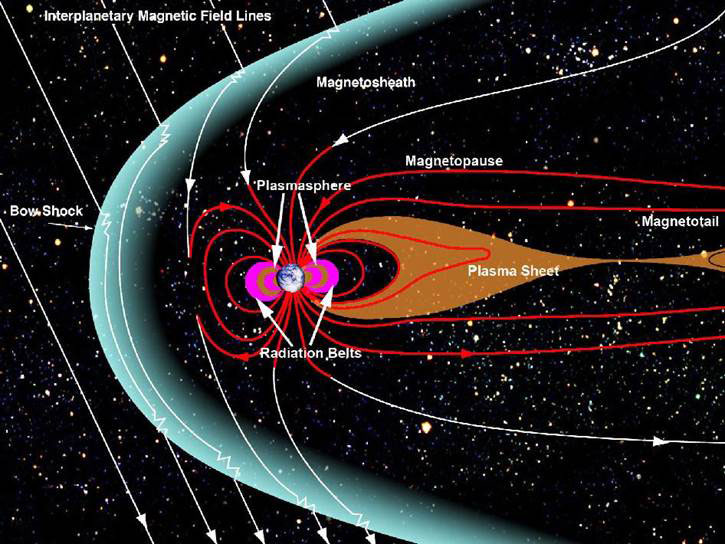
Figure 1 Earth’s magnetosphere and its interaction with the solar wind and the interplanetary magnetic field lines (courtesy of NASA)
The Sun’s atmosphere (corona) where the solar wind originates extends millions of kilometres into space and consists of highly conducting plasma in which vertical currents of 1011-1012 A are common in active regions of solar flares.
The Van Allen Radiation belts are located in the inner region of Earth’s magnetosphere (overlapping with the outer plasmasphere). The magnetopause exists at a distance of 6 to 15 Re above Earth’s surface. It is the result of the interaction between the supersonic solar wind and Earth’s magnetic field. The speed of the solar wind decreases as it approaches the magnetopause. Earth’s magnetopause is like a sieve because it allows some solar wind particles to enter. Both the magnetopause and the bowshock are dynamic, changing with the solar wind.
A Birkeland current is an electric current that flows along magnetic field lines, and was first predicted by Norwegian physicist Kristian Birkeland in 1908 as being responsible for auroras (see [6] Electric Plasma Universe Arrives, SiS 68). But it was not until in situ measurements were carried out in the ionosphere and their interpretation in terms of field-aligned currents in the late 1960s that the existence of such currents became generally appreciated. When the full longitudinal extent of these currents became known and their strengths correctly estimated at ~106 A, these current systems began to receive proper recognition as playing a fundamental role in magnetospheric processes, and they were named after Birkeland [7].
As early as 1939, Norwegian plasma physicist and Nobel laureate Hannes Alfvén had already proposed that Birkeland currents play a crucial role in transmitting electromagnetic energy from the Sun to Earth and in creating the auroras [8]. Auroras are electrical plasma discharges caused by bombardment of atoms in the upper atmosphere by 1-20 keV electrons and 200 keV ions spiralling down Earth’s magnetic field lines at high latitudes and colliding with gas particles in the ionosphere and exciting them [4, 5]. Oxygen emissions are green or red-orange, depending on the amount of energy absorbed. Nitrogen emissions are blue or red, blue if the atom regains an electron after it has been ionized, red if returning to the ground state from an excited state. According to Alfvén’s mathematical model, auroras are initiated by an electric field containing charged particles streaming from the Sun (the solar wind) interacting with the magnetic field lines of Earth at the equatorial plane [8]. (His calculations showed that the electric field was critical and would give the same results even if no charged particles were transported.) This gives rise to circular currents (of separated electrons and protons) at the equatorial plane, which then flow along Earth’s magnetic field lines (in field-aligned Birkeland currents) to discharge in the ionosphere of a ring shaped auroral zone around Earth’s magnetic poles. This was almost precisely as envisaged by Birkeland, who reproduced aurora-like discharge around the poles of a magnetized mini-Earth or terrella by firing an electron beam at it. A more exact test of Alfvén’s electric field theory was provided by experiments in which an electric field was applied to the magnetized terrella, and rings were produced around the poles from a beam of ionized gas [9] (Figure 2), as predicted by the theory.
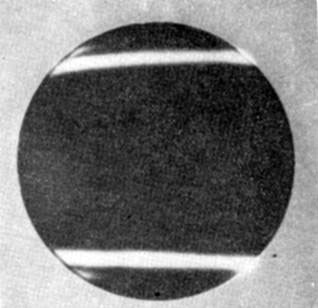
Figure 2 A terella experiment producing aurora like discharges at the poles as predicted by Alfvén’s electric field theory [8]
Numerous measurements in space and on the ground since have revealed a complex pattern of current flows in the ionosphere of Earth in combination with the sheets of Birkeland currents between the ionosphere and Earth’s plasmasphere (Figure 3, Figure 4) that bear out Alfvén’s model.
The Birkeland currents R1 and R2 are sheets surrounding the pole; arrows indicate the direction of the current or flow of positive ions (protons) by convention, and electrons move in the opposite direction. The R1 currents are coupled to the outer magnetosphere boundaries and R2 to the partial ring current in the equatorial plane of the inner magnetosphere. Additional Birkeland currents into the auroral zone during periods of enhanced solar activity, the cusp currents, are due to temporary connection between the IMF and Earth’s magnetic field lines (not shown) and substorm currents from the magnetotail (Fig. 4).
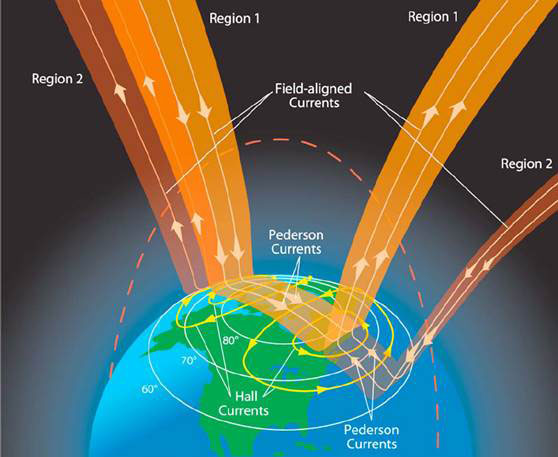
Figure 3 Schematic of combined Birkeland currents Regions 1 and 2) and ionospheric current systems (Pederson currents, and Hall Currents) from [10])
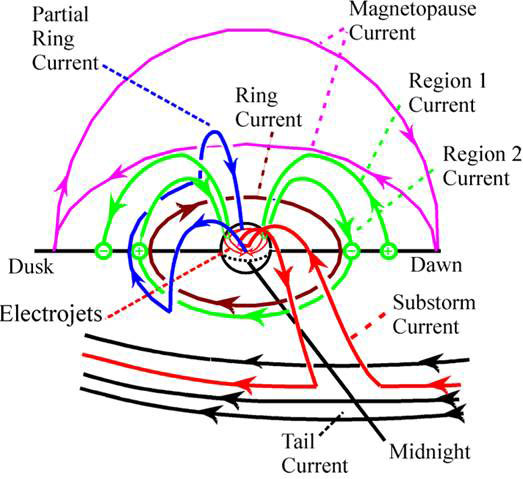
Figure 4 Currents projecting into and out of Earth’s ionosphere at the North magnetic pole connecting it to the plasmasphere and magnetosphere (from [11])
In June 2015, much excitement was generated by the direct imaging of “tubular plasma structures” in the sky [12]. This was part of Cleo Loi’s award-winning undergraduate thesis at the University of Sydney Australia using the Murchison Widefield Array radiotelescope located in the Western Australian desert. These tubular plasma structures, seen about 600 km above the ground in the upper ionosphere “appear to be continuing upwards into the plasmasphere” and “aligned beautifully with the Earth’s magnetic field lines,” according to Loi. Although the researchers did not say so in their press release or in the paper reporting the results [13], the field-aligned tubular plasma structures look very much like filamentous Birkeland currents.
Birkeland currents play a key role in Sun-Earth connection, apart from the Region 1 and 2 systems that seem to be permanent features. Space-physicist David Sibeck of NASA’s Goddard Space Flight Center identified the ‘flux transfer event’ during which a magnetic portal opens in Earth’s magnetosphere and through which “tons of high-energy particles” may flow through the opening from the Sun before it closes again in a matter of minutes [14]. Researchers have known for a long time that Earth and Sun must be connected because Earth’s magnetosphere is filled with particles in the solar wind that breaches the Earth’s magnetic shield by following magnetic field lines (in Birkeland currents, although the term was not explicitly used by the NASA researchers) that can be traced from Earth all the way to the Sun’s corona. But these connections are not steady at all. “They are brief, bursty and very dynamic.” Sibeck said.
On the day side, Earth’s magnetic field presses against the Sun’s magnetic field, and approximately every 8 minutes, the two fields briefly merge, forming a portal through which particles can flow. The ‘portal’ takes the form of a “magnetic cylinder about as wide as Earth” (are these Birkeland currents?). The European Space Agency’s four Cluster spacecraft and NASA’s five THEMIS probes have flown through and surrounded those cylinders and measured their dimensions and sensed the particles that shoot through. Space physicist Jimmy Raeder at the University of New Hampshire presented one simulation using those measurements, showing that the cylindrical portals tend to form above Earth’s equator then “roll over” Earth’s winter pole, i.e., the north pole in December and south pole in July (see Figure 5). NASA’s mission MMS (Magnetospheric Multiscale Mission) of 4 identical spacecraft flying in a tetrahedral formation launched 13 March 2015 is designed to gather information on the detailed plasma physics of such ‘magnetic reconnection’ [15].
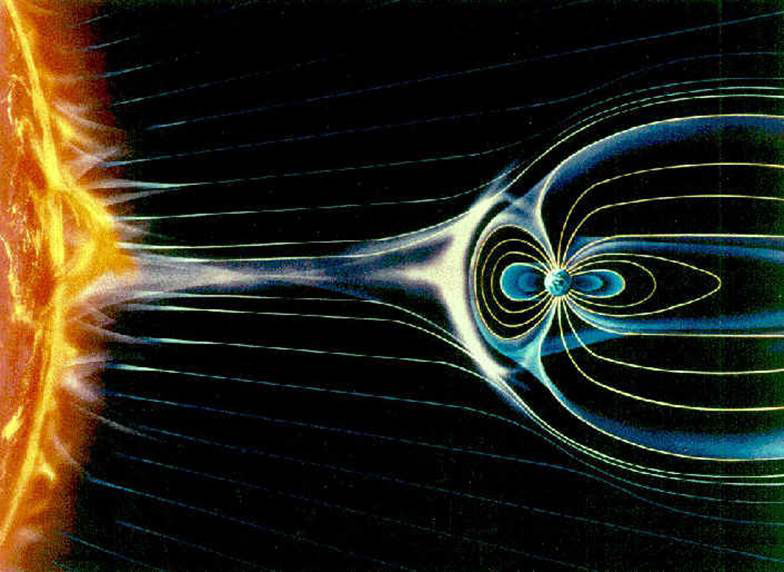
Figure 5 Earth-Sun magnetic flux connection, artist representation
In order to generate the auroras, the particles precipitating to the upper atmosphere have to acquire substantial energy to excite the atmospheric gas particles. In answer to a critic of his electric field theory, Alfvén first proposed in 1958 that electrical double layers (DLs, see [6] for detailed explanation) with sharp potential drops within the plasma current could be responsible for accelerating electrons for the aurora discharge [16]. A simplified model of the aurora circuit Alfvén presented nearly 30 years later [17] shows magnetic field-aligned Birkeland currents connecting Earth’s ionosphere to the plasma cloud in the magnetosphere near Earth’s equatorial plane moving in the sun direction, not unlike the current loop of region 1 and region 2 Birkeland currents in Figure 4. The circuit contains a double layer DL with the voltage drop ΔV, in which the current releases energy at the rate p = IΔV to accelerate aurora electrons.
Alfvén’s model has stood the test of numerous satellite observations and space-craft measurements. By the early 1990s, observations of parallel electric fields in the aurora Birkeland currents due to DLs were already numerous, and include precipitating auroral electrons with an ‘acceleration boundary’ in velocity; up-going beams of ions with a distribution function indicative of passage through a potential drop; artificial ion beams injected upwards from the ionosphere observed to undergo sudden accelerations along the magnetic field whereas artificial electron beams injected upwards were reflected away, consistent with a potential barrier above; electric field measurements revealing the existence of numerous weak electric DLs that together may account for substantial potential drops (for accelerating electrons); and direct measurement of large parallel electric field components associated with strong localized aurora fields [18].
More recently, electric fields parallel to the magnetic field lines reaching hundreds of mV/m have been measured by the Polar and FAST space crafts dedicated to studying the plasma physics of the aurora, the latter spacecraft has encountered strong DLs also in the downward current. These aurora DLs have been successfully simulated both numerically and in laboratory experiments [19]. Indeed, field aligned currents were simultaneously sampled in the ionosphere at low altitude (~500 km) and in the magnetosphere at medium altitude (~2.5 Re) by the European Space Agency’s Swarm and Cluster satellites [20]. As the space plasma researchers concluded [19]: “The auroral current circuit can be seen as consisting of four circuit elements a generator in the magnetosphere, a load in the ionosphere, and the upward and downward current regions that couple the generator and the load together.” That is essentially Alfvén’s model presented in his keynote address to a NASA workshop on Double Layers in Astrophysics in 1986 [17], in which he stressed the importance of double layers (as well as Birkeland currents) not only in Earth’s magnetosphere and Earth-Sun connection but in heliospheric, galactic, and intergalactic circuits.
The Van Allen belts were the first discovery of the space age with the launch of the US satellite Explorer 1 in 1958 (see Figure 1). Since then, the size of the two belts has been found to change, merging or even separating into three belts occasionally. Generally the inner belt is 600 to 9 600 km above Earth’s surface and the outer belt 13 500 to 58 000 km above Earth's surface, the two separated by a relatively empty slot.The Van Allen Probes data show that the inner edge of the outer belt is highly pronounced. It is a sharp boundary that under normal circumstances even the fastest electrons cannot penetrate [21]. The radiation belt electron move remarkably quickly, not towards Earth, but in giant loops along Earth’s magnetic field lines.
The radiation belts overlap with the cloud of relatively cool charged particles of the plasmasphere, which fills the outermost region of Earth’s atmosphere (see Fig. 1). The plasmasphere begins at ~1 000 km above Earth’s surface and extends into the outer Van Allen belt. The particles at the outer boundary of the plasmasphere cause particles in the outer radiation belt to scatter, removing them from the belt. The Van Allen Probes data show that in the direction towards Earth, there is hardly any movement of radiation belt electrons except for a gentle, slow drift that occurs over the course of months. This movement is so slow and weak that it is rebuffed by scattering due to the plasmasphere. Only under extreme conditions, such as when especially strong solar winds or giant coronal mass ejections from the Sun send clouds of material towards Earth that the electrons from the outer belt can be pushed into the usually empty slot between the outer and inner belt.
In 2012, shortly after the Van Allen probes A and B were launched, huge numbers of DLs carrying electric fields parallel to the local magnetic field line were observed in connection with in situ relativistic electron acceleration in the outer Van Allen belt. In one case, 7 000 DLs were observed in 1 min to produce 230 000 V net parallel potential drop crossing the space craft [22]. Lower resolution data showed that this event lasted 6 min and that more than 1 MV of net parallel potential crossed the spacecraft during that time. The DLs were not static but extremely dynamic. A DL traverses the length of a magnetic field line in about 15s and the orbital motion of the spacecraft perpendicular to the magnetic field was about 700 km during the 6 min interval. The association of double layers with relativistic electron acceleration is suggested by the measured flux of 2.5 MeV electrons showing a nearly 3 orders of magnitude increase in a fraction of a day, coinciding with 9 brief events during which intense streams of DLs were observed. The probe data suggest that DLs may be necessary for relativistic electron acceleration.
The bowshock is Earth’s first barrier against the solar wind (Fig. 1). The foreshock region, next to the bow shock, begins on the Interplanetary Magnetic Field line connected to the bow shock and is filled by backstreaming superthermal particles. THEMIS (The Time History of Events and Macroscale Interactions during Substorms) was originally a constellation of 5 NASA satellites launched to study energy releases from Earth’s magnetosphere known as substorms, magnetic phenomena that intensify auroras near Earth’s poles (see Fig. 4). On 14 September 2008, THEMIS recorded multiple double layers in the ramp (transition region) and the foreshock of Earth’s bow shock under enhanced pressure in the solar wind. The observations and detailed analysis carried out by China’s National University of Defence Technology at Changsa revealed that the double layers typically lasts 3-8 ms, their max parallel electric field -10 to -40 mV/m, their spatial scale estimated to be 0.3-1.15 km and potential drop 5-32 V. These DLs are current-carrying [23].
The electric plasma universe has truly arrived at our doorstep. The crucial roles of field-aligned plasma currents and electric double layers predicted some 50-60 years ago by Alfvén and others have proven correct. But the extent and dynamism of electric plasma current connections between Earth and Sun, and the ubiquity and mercurial appearance of electric double layers have taken even committed plasma physicists by surprise. A whole new vista of the universe is opening up. We shall look beyond Earth’s magnetosphere for more exciting revelations.
Article first published 23/09/15
Got something to say about this page? Comment
There are 1 comments on this article so far. Add your comment above.
tony Comment left 28th September 2015 16:04:10
Quite fascinating. Amazingly simple.